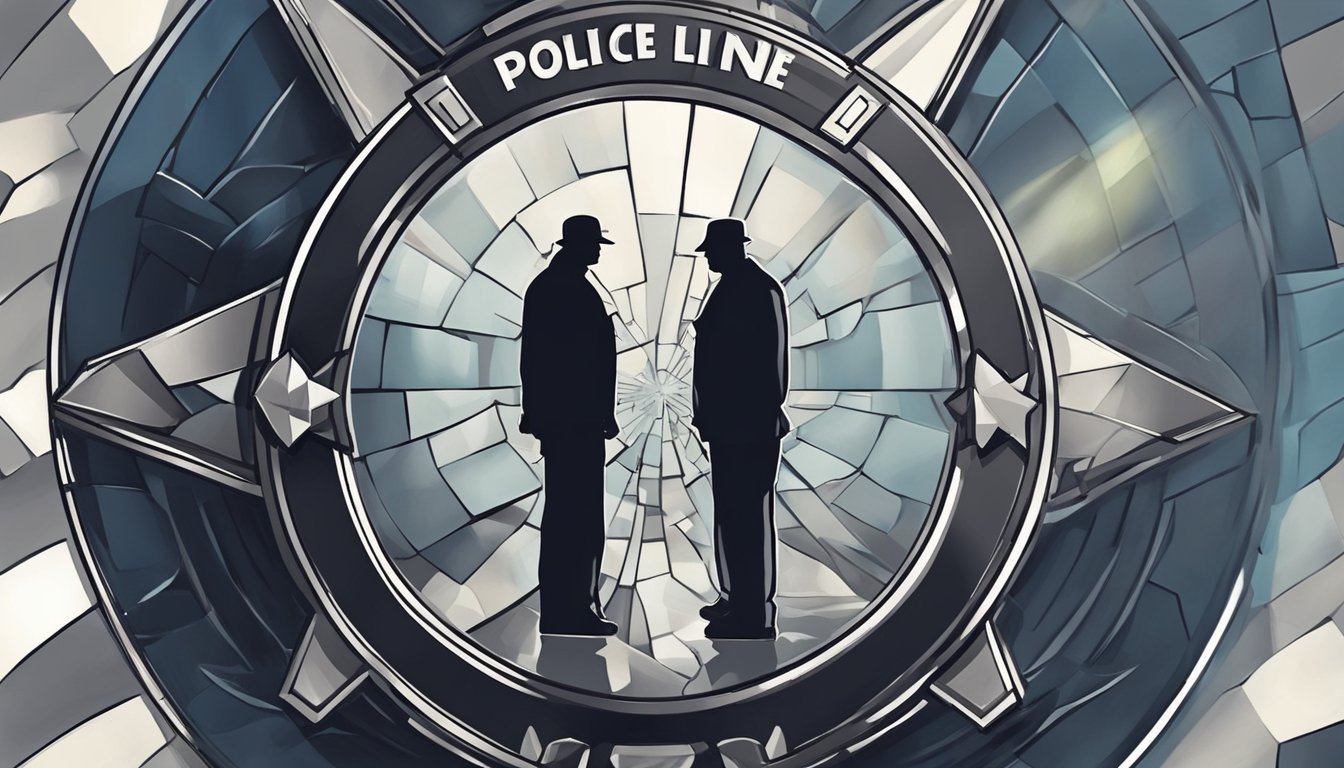American Nightmare: Exploring the Thin Line Between Victim and Suspect
Justice System Complexities Revealed
American Nightmare, a Netflix true crime series, delves into a harrowing case that blurs the line between victim and suspect. In March 2015, Denise Huskins was abducted from her boyfriend Aaron Quinn's home in Vallejo, California. The incident took a shocking turn when authorities initially doubted their story, casting suspicion on Quinn himself.
The series exposes the unsettling reality that victims can sometimes be treated as suspects by law enforcement, highlighting the complexities of criminal investigations. As the events unfolded, Huskins endured a terrifying ordeal while Quinn faced intense scrutiny from police who questioned the credibility of his account.
This case challenges viewers to examine their preconceptions about crime victims and the criminal justice system. American Nightmare raises important questions about the treatment of those who report crimes and the potential consequences of hasty judgments in high-pressure situations.
The Kidnapping of Aaron Quinn and Denise Huskins
The 2015 kidnapping of Denise Huskins from her boyfriend Aaron Quinn's home in Vallejo, California shocked the community and exposed serious flaws in the police response. The case took unexpected turns as the victims found themselves under suspicion.
A Timeline of Events
On March 23, 2015 around 3 AM, intruders broke into Aaron Quinn's Vallejo home. The couple was awakened by bright lights shining in their eyes. Masked men drugged Quinn and Huskins before abducting Denise.
Quinn was bound and given instructions for a ransom payment. The kidnappers demanded $8,500 for Huskins' safe return.
On March 25, Huskins was released in Huntington Beach, 400 miles away. She had been held for 48 hours.
Quinn cooperated with police throughout the ordeal. He provided details about the home invasion and kidnapping to investigators.
The Initial Response from Vallejo Police
Vallejo police quickly cast doubt on Quinn's account of the kidnapping. They questioned his delayed reporting of the crime and scrutinized inconsistencies in his story.
Investigators publicly labeled the case a hoax. They suggested Quinn and Huskins had fabricated the abduction.
The police's skepticism intensified after Huskins reappeared. Her return and lack of injuries fueled suspicions of a staged event.
Law enforcement openly compared the case to the film "Gone Girl." This premature conclusion severely impacted the investigation and the victims' credibility.
The police's dismissive stance hindered a thorough examination of evidence. Key leads were overlooked in the rush to discredit Quinn and Huskins' accounts.
The Gone Girl Comparison
The Gone Girl comparison significantly impacted the Denise Huskins case, shaping media coverage and public perception. This parallel to the popular novel and film influenced how the story was framed and understood by both authorities and the general public.
Media Narratives and Public Perception
Media outlets drew comparisons between Denise Huskins' kidnapping and the fictional plot of Gone Girl. This framing led to widespread skepticism about the case's authenticity. News reports emphasized sensational details, blurring the line between fact and fiction. The public struggled to separate reality from dramatic narratives.
This comparison had severe consequences for Huskins and her family. It fueled public doubt and caused additional trauma for the victims. Law enforcement initially treated the case with suspicion, influenced by the media's portrayal.
Gillian Flynn and the Real-life Gone Girl Label
Gillian Flynn's novel Gone Girl became an unexpected reference point in the Huskins case. The "Real-life Gone Girl" label stuck, despite its inaccuracy. This comparison highlighted the power of storytelling in shaping public opinion.
The book's plot, involving a faked kidnapping, overshadowed the true events of Huskins' ordeal. Media outlets used the Gone Girl narrative as a shorthand to explain the case. This simplification overlooked crucial facts and complexities of the real situation.
The label persisted even after the truth emerged, demonstrating the lasting impact of fictional narratives on real-world events.
The Vallejo Police Investigation
The Vallejo Police Department's handling of the Denise Huskins case was marred by significant errors and controversial practices. Their approach raised serious concerns about investigative procedures and treatment of victims.
Mistakes and Missteps
The Vallejo police made critical errors in their investigation of Denise Huskins' kidnapping. They quickly dismissed the abduction as a hoax, prematurely labeling it a "Gone Girl" scenario. This rushed judgment led to a flawed investigation that overlooked key evidence.
Detectives failed to thoroughly process the crime scene or follow up on potential leads. They disregarded physical evidence that supported the victims' accounts. The department's premature public statements declaring the case a hoax damaged their credibility and hindered the investigation.
These missteps allowed the real perpetrator to remain free, potentially endangering others in the community.
Interrogation and Victim Blaming
The Vallejo police's interrogation techniques came under scrutiny for their aggressive and accusatory nature. Detectives subjected Aaron Quinn to lengthy, confrontational questioning while he was still under the influence of drugs given by the kidnapper.
They openly expressed disbelief in his story and accused him of involvement in Huskins' disappearance. This approach of treating victims as suspects extended to Huskins herself upon her return.
The police publicly accused the couple of fabricating the kidnapping, causing significant trauma and reputational damage. This victim-blaming stance persisted even as evidence emerged supporting their account.
The department's actions highlighted systemic issues in handling sensitive cases and treating victims with empathy and professionalism.
Matthew Muller: The Perpetrator
Matthew Muller, a former Marine and Harvard Law School graduate, orchestrated the shocking kidnapping of Denise Huskins in 2015. His actions led to a complex investigation that initially cast doubt on the victims before revealing the true nature of his crimes.
Capture and Confession
The FBI linked Muller to the kidnapping through evidence found at another attempted home invasion. A cell phone left behind at the scene contained Muller's address. When authorities searched his residence, they discovered items connecting him to Huskins' abduction.
Faced with overwhelming evidence, Muller confessed to the crime. He admitted to breaking into Huskins and Aaron Quinn's home in Vallejo, California, in the early hours of March 23, 2015. Muller's confession provided crucial details about the kidnapping, helping to clear Huskins and Quinn of any suspicion.
Profile of a Kidnapper
Muller's background presents a stark contrast to his criminal actions. He attended Harvard Law School and practiced as an attorney before being disbarred. Diagnosed with bipolar disorder, Muller's mental health likely played a role in his criminal behavior.
Investigations revealed Muller's involvement in several other home invasions. His meticulous planning and use of sophisticated equipment demonstrated a calculated approach to crime. In 2017, U.S. District Judge Troy L. Nunley sentenced Muller to 40 years in prison, citing his "considerable intelligence" in conducting "physical assault and psychological torture" on his victims.
The Fallout and Aftermath
The aftermath of the Denise Huskins case exposed serious flaws in law enforcement practices and had lasting impacts on the lives of those involved. Efforts to address police misconduct and restore reputations became central issues in the wake of this ordeal.
The Role of Law Enforcement Accountability
The Vallejo Police Department faced intense scrutiny for their mishandling of the Huskins case. A $2.5 million settlement was reached between Huskins, Quinn, and the city of Vallejo. This highlighted the need for improved police accountability measures.
Law enforcement agencies implemented new training programs focused on victim sensitivity and avoiding premature judgments. Independent review boards were established in some jurisdictions to evaluate police conduct in high-profile cases.
The case sparked discussions about reforming policies related to false reporting accusations against crime victims. Many advocates pushed for stricter guidelines before labeling alleged victims as suspects.
Reputations and the Road to Recovery
Huskins and Quinn faced significant challenges in rebuilding their lives and reputations after being falsely accused. They pursued legal action against media outlets for defamation to address the damage done to their public image.
The couple got married in 2018 and started a family, welcoming two daughters. They relocated to California's Central Coast to begin a new chapter away from the spotlight.
Huskins became an advocate for crime victims' rights, sharing her story to raise awareness about the impact of wrongful accusations. She worked with lawmakers to strengthen protections for individuals wrongly implicated in crimes.
Quinn struggled with trauma and PTSD stemming from the ordeal. He sought therapy and gradually returned to work, rebuilding his professional life over time.
Impact on Popular Culture
The American Nightmare case captured public attention and influenced media portrayals of crime. It reshaped perceptions of victim credibility and law enforcement practices in high-profile cases.
Netflix's Role in True Crime Storytelling
Netflix's docuseries "American Nightmare" brought renewed focus to the Denise Huskins case. The show presented a detailed account of the events, challenging initial skepticism about Huskins' kidnapping.
It highlighted the dangers of premature judgments in criminal investigations. The series sparked discussions about media responsibility in reporting on ongoing cases.
Netflix's platform allowed for a nuanced exploration of the complex story, reaching a global audience. This exposure led to increased scrutiny of similar cases and police procedures.
Influence on Domestic Violence and Kidnapping Narratives
The Huskins case altered public discourse on domestic violence and kidnapping. It exposed the potential for victim-blaming in sexual assault cases, even by law enforcement.
Media coverage shifted towards more empathetic reporting on victims' experiences. The case prompted reevaluation of how authorities handle kidnapping reports and assess victim credibility.
It also raised awareness about the psychological impact of disbelief on victims of violent crimes. This shift influenced training protocols for law enforcement in handling sensitive cases.
The story's similarities to the film "Gone Girl" highlighted the complex relationship between fiction and real-life crime narratives.
Conclusion
The "American Nightmare" case blurs the line between victim and suspect. It highlights the complexities of criminal investigations and the potential for miscarriage of justice.
The events in Vallejo, CA shocked the community and exposed flaws in local law enforcement. The case's twists and turns captivated audiences, sparking discussions about police procedures and victim treatment.
Physical therapists Denise Huskins and Aaron Quinn faced intense scrutiny. Their ordeal sheds light on the challenges victims can encounter when their stories seem implausible.
The documentary's storytelling approach presents multiple perspectives. It encourages viewers to question assumptions and consider the nuances of criminal cases.
Huntington Beach played a role in the investigation, demonstrating the importance of inter-agency cooperation. The case's resolution required looking beyond initial appearances and following evidence diligently.
"American Nightmare" serves as a cautionary tale. It reminds us that truth can be stranger than fiction and that rushing to judgment can have severe consequences for all involved.







